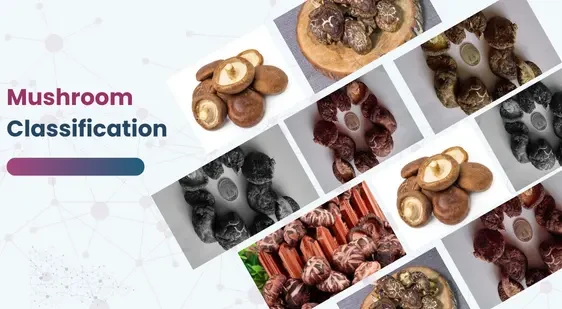Mushroom Classification
Mushroom Classification
Datasets
Mushroom Classification
File
Mushroom Classification
Use Case
Computer Vision
Description
There are over 20 types of mushrooms.

About Dataset
Mushroom classification data sets are crucial tools for both researchers and enthusiasts in mycology—the study of fungi. These data sets typically contain extensive information about various mushroom species, which is essential for accurate identification, research, and analysis. Here, we’ll explore the components and significance of a mushroom classification data set.
Components of a Mushroom Classification Data Set
A comprehensive mushroom classification data set includes multiple attributes that describe the physical and biological characteristics of mushrooms. Key attributes often found in such data sets include:
- Cap Shape: The shape of the mushroom’s cap, such as bell, conical, or flat.
- Cap Surface: The texture of the cap surface, like smooth, scaly, or fibrous.
- Cap Color: The color of the mushroom cap, which can vary widely across species.
- Gill Attachment: How the gills (spore-bearing structures) attach to the stem, including attached, free, or descending.
- Gill Spacing: The density of the gills, whether they are close or spaced.
- Gill Color: The color of the gills, which can help in identifying the species.
- Stalk Shape: The shape of the mushroom stalk, whether it is bulbous, tapering, or equal.
- Stalk Root: The root structure, if present.
- Stalk Surface Above/Below Ring: The texture of the stalk above and below the ring, if the mushroom has one.
- Stalk Color Above/Below Ring: The color of the stalk above and below the ring.
- Veil Type: The type of veil, which covers immature mushroom gills.
- Veil Color: The color of the veil.
- Ring Number: The number of rings on the stalk.
- Ring Type: The type of ring, such as large, small, or none.
- Spore Print Color: The color of the spore print, obtained by placing the cap on a surface and collecting spores.
- Population: The population density where the mushroom is found, such as solitary, clustered, or numerous.
- Habitat: The environment where the mushroom grows, including woods, meadows, or urban areas.
Significance of Mushroom Classification Data Sets
Mushroom classification data sets serve several important purposes:
- Identification: They help in identifying mushroom species accurately, which is vital for both amateur mushroom foragers and professional mycologists.
- Research: These data sets provide a rich source of information for scientific research, enabling studies on fungal diversity, ecology, and phylogeny.
- Safety: Accurate classification helps in distinguishing edible mushrooms from poisonous ones, ensuring safe foraging and consumption.
- Conservation: Understanding mushroom species and their habitats can aid in conservation efforts and maintaining biodiversity.
By leveraging mushroom classification data sets, researchers and enthusiasts can enhance their understanding of fungal species, contribute to scientific knowledge, and promote safe and sustainable interactions with the natural world.
Contact Us

Quality Data Creation

Guaranteed TAT

ISO 9001:2015, ISO/IEC 27001:2013 Certified

HIPAA Compliance

GDPR Compliance

Compliance and Security
Let's Discuss your Data collection Requirement With Us
To get a detailed estimation of requirements please reach us.